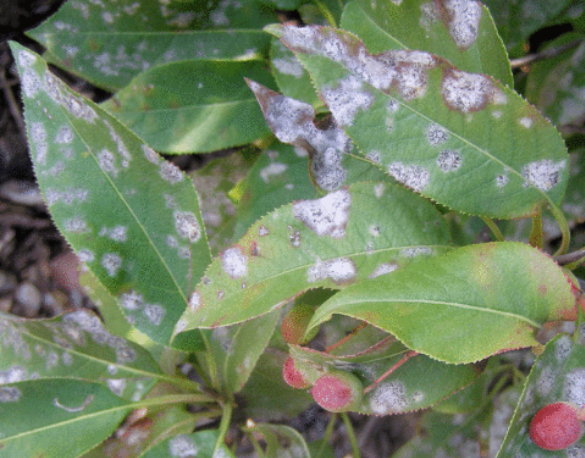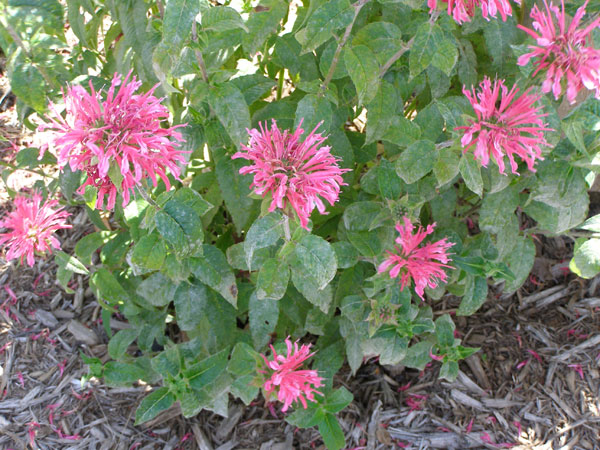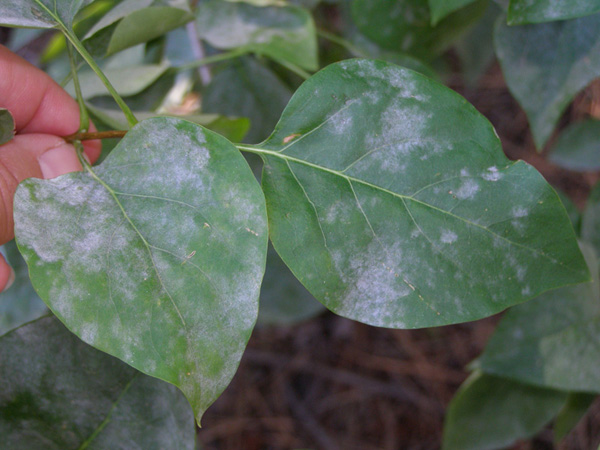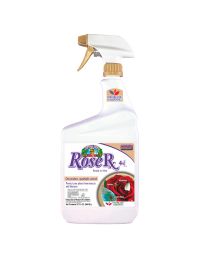Powdery mildew is a fungal disease that attacks a wide variety of woody shrubs and plants. Infections range from a light dusting of powdery white spots to leaves completely covered with dense white felt. Ninebark, especially varieties with dark leaves), Arrowwood Viburnum and Lilac are just a few of the ornamental shrubs that are susceptible to this fungal disease.

Powdery mildew on viburnum
Identifying Powdery Mildew:
- White to gray powdery spots, blotches or felt-like mats form on leaves, green stems and buds. Infected plants may appear to be sprinkled with baby powder or covered in cobwebs.
- Young leaves, water sprouts and green shoots are often most severely affected.
- Infected leaves may be cupped or twisted at the site of the infection.
- When severely infected, leaves may turn yellow and fall prematurely during the growing season.
- In some plants, leaves turn purple to red around the infection.
- In late summer or early fall, tiny round orange to black balls form within white fungal mats.
If the disease starts on mature leaves, the fungus is often only a few spots or a light coating of white on an otherwise healthy-looking leaf. These infections are typically considered minor infections and have little effect on the overall health of the shrub.
If the disease comes in on young developing leaves, shoots and flowers, however, leaves may be severely affected.

Powdery mildew on monarda (beebalm)
How it survives our winters:
- The powdery mildew fungi colonize young tissue within plant buds. In this case tthe fungi start up new infections as soon as the buds open in the spring.
- A shrub with a few very severely infected young shoots next to completely healthy shoots, most likely had powdery mildew fungi surviving in its buds all winter long.
Powdery mildew fungi prefer mild weather (60-80F) and high humidity. They thrive in shade and cause the most severe infections on young, succulent shoots. The good news, most powdery mildew fungi can only cause disease in one genus or one family of plants. The powdery mildew fungi on lilac will therefore not spread to the rose bush in the yard. A different species of powdery mildew fungi must be present to infect the rose bush.

Powdery mildew on lilac
When and how to control powdery mildew:
First, many powdery mildew infections do not significantly harm the plant and therefore do not need to be controlled. Many lilacs bloom beautifully year after year despite repeated infections with powdery mildew. Mature trees may have powdery mildew on the lowest leaves, but this is such a small proportion of the canopy that the tree’s overall health is not affected. For those more severely infected:
- Prune off leaves and shoots that are distorted, yellowed, and stunted if only a few shoots are severely infected. This is true for infected flower clusters as well as leafy shoots.
- Infections on stems should be removed, since these often turn into bud infections and survive the winter in that form.
- Reduce the humidity around the plant as much as possible.
- Use mulching around the shrub with woodchips or other organic material. This will help to keep moisture in the soil.
- Improve air circulation around the plant by removing any weeds crowding the plant.
- Place shrubs in areas of the garden where there is good air movement and sun appropriate for the shrub’s needs.
- Do not over fertilize shrubs suffering from powdery mildew. Fertilizer often results in a flush of new succulent growth that is easily infected by the fungus.
- If all cultural control practices are not enough to control the disease use a protective fungicide.
- Copper fungicide, which is organic, helps control powdery mildew, early or late blight and/or leaf spot.
- Another product that works great is Fung-onil; it is a great all-purpose fungicide that can be used on any plants from your ninebark to your roses.
- If your roses are the only plant that seems to be affected by powdery mildew Rose RX 3 in1 is a great multi-purpose product; two-way triple action: insecticide – miticide – fungicide. Rose Rx 3 in 1 does contains Neem oil organic insecticide and is approved for organic gardening.
And as always please remember to read the labels and follow the instructions as directed when you’re using any chemical.
Information provided from the University of MN Extension Services.
The experts at Gertens are always available to answer your questions!

